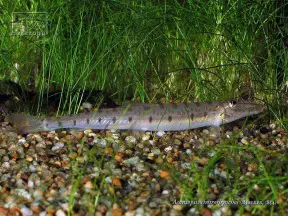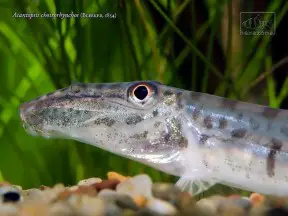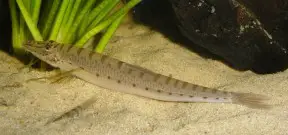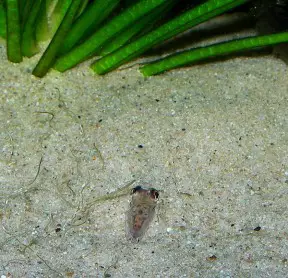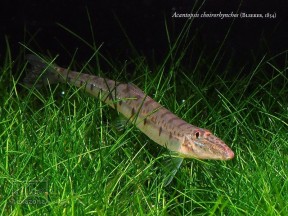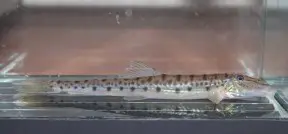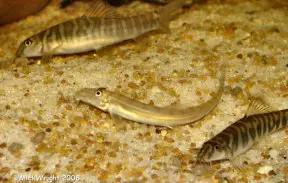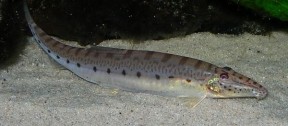Acantopsis dialuzona
Horse Face Loach
SynonymsTop ↑
Acanthopsis biaculeata van Hasselt, 1823; Cobitis choirorhynchos Bleeker, 1854; Acantopsis choirorhynchos (Bleeker, 1854); Cobitis macrorhynchos Bleeker, 1854
Aperioptus pictorius Richardson, 1848 is questioned by Kottelat (2012, 2013) but now confirmed as a distinct separate species by Page & Tangjitjaroen (2015)
Classification
Order: Cypriniformes Family: Cobitidae
Distribution
Type locality is ‘Jakarta, Java, Indonesia’ but given recent work by Kottelat (2012, see ‘Notes’) this species’ distribution is unclear. As currently understood it certainly occurs throughout the Greater Sunda Islands of Sumatra, Borneo and Java plus Peninsular Malaysia and possibly Thailand.
The taxonomy and diversity of the group is quite poorly studied, however, and populations from Sabah (Malaysian Borneo), Manipur (India) and Thailand have been described to science (as A. octoactinotos, A. multistigmatus and A. thiemmedhi, respectively) quite recently, so it would seem likely that new taxa would result from any detailed study.
It’s improbable that a significant percentage (if any) of the fish in the trade are collected from around the type locality meaning they may represent an unidentified species.
Habitat
Acantopsis species are near-exclusive inhabitants of flowing river channels with substrates of sand, fine gravel or mud but are known to migrate into temporarily flooded zones during the wet months of the year.
A survey of the Phrom River, Chaiyaphum Province, north-eastern Thailand recorded what was identified as A. choirorhynchos (currently synonymous with A. dialuzona) living alongside numerous other species including Pangio anguillaris, P. oblonga, Acanthopsoides gracilentus, Esomus metallicus, Rasbora myersi, R. paviana, Cyclocheilichthys armatus, C. repasson, Osteochilus waandersii, Puntius brevis, ‘Puntius‘ binotatus, ‘P.‘ orphoides, Garra cambodgiensis, Gyronicheilus aymonieri and three species of Mastacembelus.
Maximum Standard Length
Variable, but some of the larger forms can exceed 200 mm.
In most cases females grow considerably larger than males.
Aquarium SizeTop ↑
Base dimensions of 120 ∗ 45 cm or equivalent should be the minimum considered.
Maintenance
Not difficult to keep but must be provided with a soft, sandy substrate since some of its time will be spent completely buried, or with only eyes protruding.
When coarser material is used it may become stressed or damage itself trying to dig, and feeding behaviour can be inhibited.
Other décor can include water-worn rocks and driftwood branches and tree roots arranged to form plenty of hiding places and shaded spots – add these prior to the substrate to prevent them being toppled by digging activity.
Lighting can be quite dim unless you intend to grow plants and a few handfuls of leaf litter would complement the natural effect.
Though torrent-like conditions are unnecessary it does best if there is a high proportion of dissolved oxygen and some water movement in the tank meaning power filter(s), additional powerhead(s), or airstone(s) should be employed as necessary.
Like many fishes that naturally inhabit running water it’s intolerant to accumulation of organic pollutants and requires spotless water in order to thrive, meaning weekly water changes of 30-50% tank volume should be considered routine.
Water Conditions
Temperature: 16 – 24 °C
pH: 6.0 – 8.0
Hardness: 18 – 215 ppm
Diet
Acantopsis spp. typically sift mouthfuls of substrate through the gills from which insect larvae, small crustaceans and suchlike are extracted.
They’re not difficult to feed in aquaria but offer a varied diet comprising high quality sinking dried foods plus live and frozen Artemia, Tubifex, Daphnia, bloodworm, etc.
Behaviour and CompatibilityTop ↑
In a set-up as described above these loaches will do well alongside species that inhabit the upper part of the water column such as Rasbora, Devario, Laubuca and Barilius spp.
Sand-dwelling loaches from the families Botiidae, Cobitidae and Nemacheilidae are also suitable but proper research is essential as some can be excessively territorial or otherwise aggressive. A community based around one of its native rivers could make an interesting display with plenty of options.
It’s usually recommended to buy only a single specimen or a group of three or more but ideally six should be the fewest considered since it exists in loose aggregations in nature.
Occasional skirmishes, presumably over temporary territories, do happen but physical injury is rare.
Sexual Dimorphism
Females typically grow much larger than males, while males have modified pectoral fins with the first couple of branched rays extended.
Reproduction
Unrecorded.
NotesTop ↑
Juveniles of this ‘species‘ are exported in large numbers but it’s still uncommon to see adult specimens in the aquarium hobby suggesting their needs are not catered for often enough.
Other trade names include ‘long-nosed’ and ‘banana’ loach.
The fish identified in the aquarium hobby as “horseface loach” have most commonly been considered to be Acantopsis choirorhynchos and will be seen listed as such in the majority of printed and online literature. A. choirorhynchos is considered a junior synonym of A. dialuzona without explanation by Kottelat (2012, 2013), and we follow that designation here given the confusion surrounding the group, and pending future developments.
Acantopsis currently contains just six recognised species but should undergo significant changes in the future. Eschmeyer, 2015 lists five valid species, with a sixth, A. choirorhynchos (Bleeker 1854), a junior synonym of A. dialuzona following Kottelat (2012, 2013)
According to Rainboth (1996) members are characterised by possessing an elongate body, 9-11 branched dorsal rays, a single pair of barbels at the end of the snout, slightly forked caudal-fin and eyes without a free orbital rim.
Rainboth also recognised three species from the Cambodian section of the Mekong River and another four from the Chao Phraya which have been widely misidentified as A. choirorhynchos or A. dialuzona, although none of them appear to have been officially-described.
Roberts (1989) states that Acantopsis possess a greatly elongated head and snout with the eyes positioned dorsally, 10-13 dorsal-fin rays with the dorsal-fin origin anterior to the pelvic-fin origin, caudal-fin forked or deeply emarginate and 40-44 vertebrae. The suborbital spine (see below) is located entirely, rarely slightly, anterior to the eye rather than below it.
The family Cobitidae, often referred to as ‘true’ loaches, is widely-distributed across most of Eurasia with the Indian subcontinent, Southeast Asia and China representing particular centres of species diversity.
Phylogenetic analyses by Tang et al. (2006), Šlechtová et al. (2007) and Šlechtová et al. (2008) revealed that the group constitutes a separate genetic lineage to the family Botiidae (the two were previously grouped together under Cobitidae as subfamilies Cobitinae and Botiinae).
In the most recent study Lepidocephalichthys was not found to be as closely-related to Pangio, Lepidocephalus or Kottelatlimia as previously hypothesised though unfortunately the authors stop short of proposing an alternative theory.
All cobitids possess sharp, motile, sub-ocular spines which are normally concealed within a pouch of skin but erected when an individual is stressed, e.g. if removed from the water. Care is therefore necessary as these can become entangled in aquarium nets and with larger species even break human skin.
References
- Alfred, E. R., 1961 - Bulletin of the Raffles Museum 30: 32-37
Notes on a re-examination of some Bleeker type specimens of Indo-Malayan fresh-water fishes. Part 1, Cobitidae and Homalopteridae. - Bleeker, P., 1854 - Natuurkundig Tijdschrift voor Nederlandsch Indië 7: 49-108
Overzigt der ichthyologische fauna van Sumatra, met beschrijving van eenige nieuwe soorten. - Champasri, T., 2003 - Pakistan Journal of Biological Sciences 6(1): 65-69
Some Ecological Aspects, Water Properties and Natural Fish Species of the Phrom River in Northeast Thailand. - Kottelat, M., 2012 - Raffles Bulletin of Zoology Supplement 26: 1-199
Conspectus cobitidum: an inventory of the loaches of the world (Teleostei: Cypriniformes: Cobitoidei). - Kottelat, M., 2013 - Raffles Bulletin of Zoology Supplement No. 27: 1-663
The fishes of the inland waters of southeast Asia: a catalogue and core bibiography of the fishes known to occur in freshwaters, mangroves and estuaries. - Page, L. M. and W. Tangjitjaroen, 2015 - Zootaxa 3962 (no. 1): 179-181
Aperioptus pictorius Richardson 1848 is a senior synonym of Acanthopsoides molobrion Siebert 1991, and Aperioptus is a senior synonym of Acanthopsoides Fowler 1934 (Cypriniformes: Cobitidae). - Rainboth, W. J., 1996 - FAO, Rome: 1-265
Fishes of the Cambodian Mekong. FAO Species Identification Field Guide for Fishery Purposes. - Roberts, T., 1989 - Memoirs of the California Academy of Sciences No. 14: i-xii + 1-210
The freshwater fishes of western Borneo (Kalimantan Barat, Indonesia). - Tang, Q., H. Liu, R. Mayden and B. Xiong, 2006 - Molecular Phylogenetics and Evolution 39(2): 347-357
Comparison of evolutionary rates in the mitochondrial DNA cytochrome b gene and control region and their implications for phylogeny of the Cobitoidea (Teleostei: Cypriniformes). - Šlechtová, V., J. Bohlen and A. Perdices, 2008 - Molecular Phylogenetics and Evolution 47(2): 812-831
Molecular phylogeny of the freshwater fish family Cobitidae (Cypriniformes: Teleostei): delimitation of genera, mitochondrial introgression and evolution of sexual dimorphism. - Šlechtová, V., J. Bohlen and H. H. Tan, 2007 - Molecular Phylogenetics and Evolution 44(3): 1358-1365
Families of Cobitoidea (Teleostei; Cypriniformes) as revealed from nuclear genetic data and the position of the mysterious genera Barbucca, Psilorhynchus, Serpenticobitis and Vaillantella.
